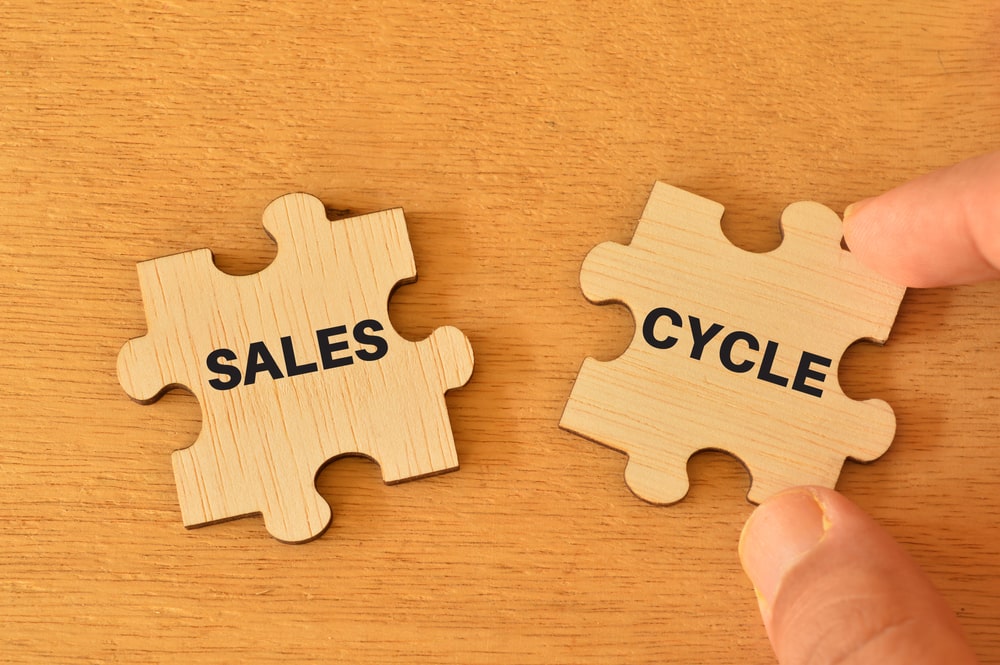To stay ahead in a competitive industry, you’ll need to evolve and innovate constantly. One of the most consistent ways to do this is to identify where your prospects are in their sales cycle. As a product or service seller, using the seven stages of the sales cycle not only helps you become more organized and productive, but they’ll make you successful in the long run.
This blog post will walk you through the seven stages of the sales cycle and how they can lead to future financial success.
The 7 Stages of the Sales Cycle
Here are the seven stages of the sales cycle. These stages should be followed systematically from the first to last.
1. Prospecting
The first stage of the sales cycle is prospecting. In this stage, you’ll need to identify who your prospects are and where they can be found.
A good way to begin prospecting is by looking at past clients whose needs have been met during previous projects or interactions with your company. You can also find new prospects through:
- Researching professional resources
- Databases
- Networking
- Referrals
- Recommendations
2. Making Contact
Once you’ve identified your prospects, it’s time to make contact. If it’s your first time doing business, you’ll need to try several means of communication before deciding which one works best for reaching your audience.
Next, make contact with your potential leads to get their attention and interest. The key here is ensuring that all communication made with them is strategic and well-thought-out so as not to discourage them from doing business with you.
3. Qualifying Your Lead
After making contact, you’ll be looking to qualify your lead. The qualification process is a critical step in the sales cycle as it will determine whether or not they are worth pursuing and investing time into.
During this stage of the sales cycle, you should take care to gather all facts about them, such as their company size and industry, so that you can determine whether or not your prospect is a viable one.
The best way to qualify leads in the sales cycle is by asking them questions about their business and goals so that you can provide them with qualified assistance based on what they respond with. You can ask questions such as:
- Has your organization ever used/considered a product/service like this before? If so, what happened?
- How do you take part in decisions your company makes?
- What does success look like to you, both in terms of quantitative and qualitative results?
- What’s your budget like for this project?
If, after qualifying your lead, it turns out that they are not worth pursuing, then move on to another lead. However, if they are a good fit for your business, then it’s time to move on to the next step in the sales cycle.
Note: It is important that you should find out their needs before providing any help or advice.
4. Nurturing Your Lead
After qualifying your leads, you’ll want to nurture them. Nurturing is all about laying the groundwork for a future long-term relationship by staying top of mind through email outreach and social media engagement.
For example, if they have a question or issue related to something you can help with, sending an email with a solution is highly recommended.
You can also nurture by providing helpful;
- Case studies
- Reports
- White papers
- Testimonials
- Statistics
- Webinars
5. Presenting Your Offer
Next up in the sales cycle is presenting your offer. This stage of the process should be done after you’ve qualified and nurtured your lead so as not to shock or overwhelm them.
It’s important to note that you should present your offer in a way that’s not pushy or demanding.
You should focus on benefits rather than features to highlight what they will get from doing business with you. It’s also imperative that you provide proof or evidence as well.
6. Overcoming Objections
Not all leads will be willing or able to do business with you right away, so you must be prepared for any potential objections they might have. In this stage of the sales cycle, a good approach is by asking them questions about their main objections and addressing them in your follow-up email or call.
7. Closing the Sale
The final step of the sales cycle is to close your lead with a powerful offer and strong guarantee. This stage should be done by taking advantage of what you’ve learned about them during the qualification process, which can help you take the right steps to close them.
It’s important that you’re confident and “own” your offer, to avoid coming across as desperate or needy.
Some points to highlight in your sale can be:
- Benefits
- Urgency
- Trust in person/company
- Social proof
- Testimonials
You should also be prepared to answer any questions they may have about what comes next. Post-sale relationships can make or break a business over time.
After closing the sale, it’s time to follow up with them and continue nurturing your lead. This way, you can continue building trust and rapport as well as keep their business.
Long-Term Thinking
Remember, this process should be done systematically and not in a way that will overwhelm or confuse your prospect… or you. Following the steps above will not only help you to stay organized and on track, but it can also make a significant difference in your sales performance.

